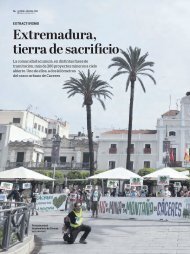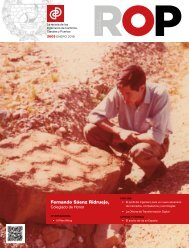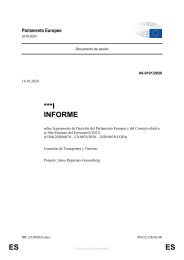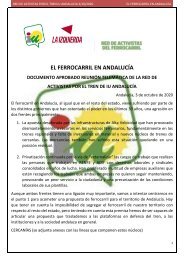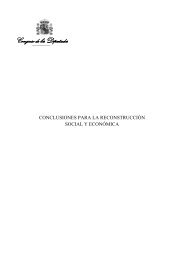La Red de Alta Velocidad Europea: Más un mosaico poco efectivo que una realidad
El presente comunicado de prensa tiene por objeto ofrecer una síntesis del contenido esencial del informe especial del Tribunal de Cuentas Europeo. El texto íntegro del informe puede consultarse en www.eca.europa.eu.
El presente comunicado de prensa tiene por objeto ofrecer una síntesis del contenido esencial del informe especial del
Tribunal de Cuentas Europeo.
El texto íntegro del informe puede consultarse en www.eca.europa.eu.
You also want an ePaper? Increase the reach of your titles
YUMPU automatically turns print PDFs into web optimized ePapers that Google loves.
XI.<br />
The Commission refers to its replies to recommendation 1.<br />
The Commission refers to its replies to recommendation 2.<br />
The Commission refers to its replies to recommendation 3.<br />
The Commission refers to its replies to recommendation 4.<br />
OBSERVATIONS<br />
23. The TEN-T Regulation provi<strong>de</strong>s for a strategic and ambitious rail network planning from an EU<br />
perspective covering whole of the EU, and zooming in on those parts of the network that are to be<br />
<strong>de</strong>veloped according to high speed standards. High-speed railways are <strong>de</strong>fined in the TEN-T<br />
Regulation, vi<strong>de</strong> point (a) of the art. 11.2.<br />
26. The Commission is not involved directly in the <strong>de</strong>cision-making in the Member States.<br />
However, the TEN-T Regulation translates the strategy <strong>de</strong>veloped by the Commission in the White<br />
Paper 2011 into concrete objectives, specific targets and appropriate measures.<br />
This Regulation <strong>de</strong>fines the EU infrastructure policy for transport and the criteria to i<strong>de</strong>ntify the<br />
projects of EU common interest.<br />
A set of tools <strong>de</strong>fined in the TEN-T and CEF Regulations – notably the core network corridors –<br />
allow the Commission to verify that the Member States comply with their commitments <strong>un</strong><strong>de</strong>r the<br />
Regulations and to take action where necessary.<br />
<strong>Europea</strong>n Coordinators release core network work plans, which highlight main challenges and<br />
monitor progress ma<strong>de</strong>. These work plans are approved by the Member States concerned and are<br />
publicly available.<br />
In addition, the TEN-T regulation foresees the possibility for the Commission to adopt<br />
implementing <strong>de</strong>cisions on specific cross-bor<strong>de</strong>r sections (for example Evora-Merida, Rail Baltica,<br />
etc.). See also Commission reply to paragraph 31.<br />
The Commission consi<strong>de</strong>rs that the <strong>de</strong>adline of 2030 for the completion of the core TEN-T is<br />
binding although <strong>de</strong>pending on the availability of financial resources in the Member States.<br />
In the programming period 2014-2020 the Commission has reinforced the planning framework of<br />
Member States and regions for transport investments, including high-speed rail. Cohesion policy<br />
support to such investments was conditional to the existence of comprehensive transport<br />
strategy(ies) or framework(s) that ensure planning security for all stakehol<strong>de</strong>rs: EU, national and<br />
private. The Commission has proposed to maintain enabling conditions for the 2021-27 period.<br />
31. The Commission indicates that coordination tools for cross-bor<strong>de</strong>r sections already exist <strong>un</strong><strong>de</strong>r<br />
the framework of the current programming period:<br />
1) According to the TEN-T regulation, the Commission can adopt implementing <strong>de</strong>cisions for<br />
cross-bor<strong>de</strong>r projects. This has been done for the first time with the implementing <strong>de</strong>cision on the<br />
Evora-Merida project adopted on 25 April 2018.<br />
2) On technical elements and interoperability, the <strong>Europea</strong>n Deployment Plan for ERTMS<br />
(COMMISSION IMPLEMENTING REGULATION (EU) 2017/6) mandates a cross-bor<strong>de</strong>r<br />
agreement on ERTMS.<br />
Box 1 – Poorly connected national networks, and their impact<br />
1. According to available information and its own assessment, the Commission believes that the<br />
access routes should become operational gradually between 2027 and 2040.<br />
2










